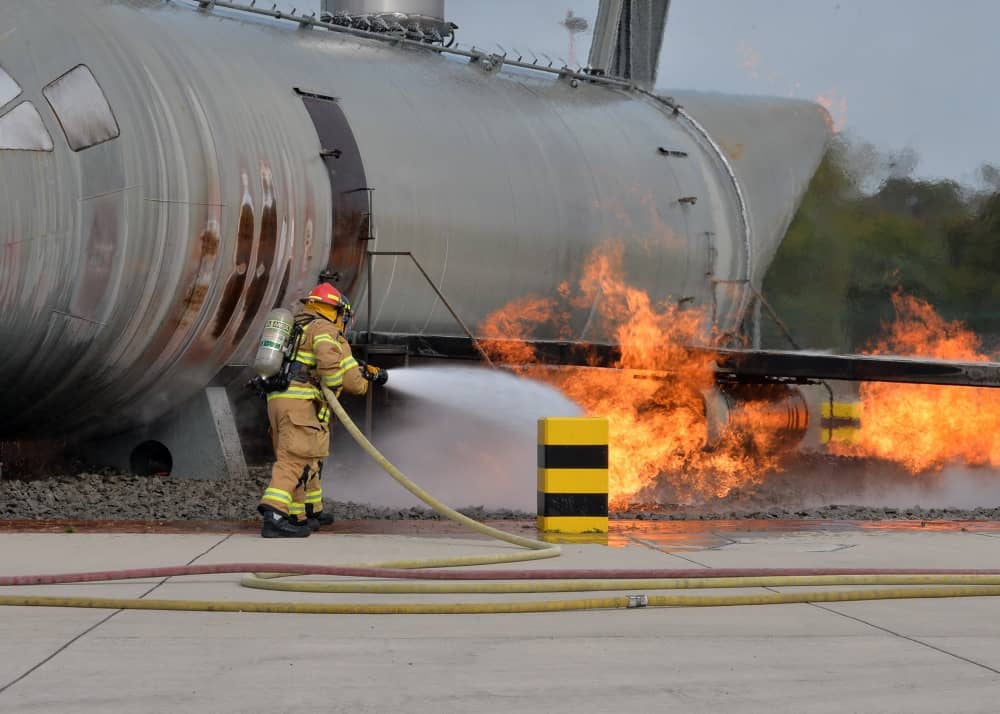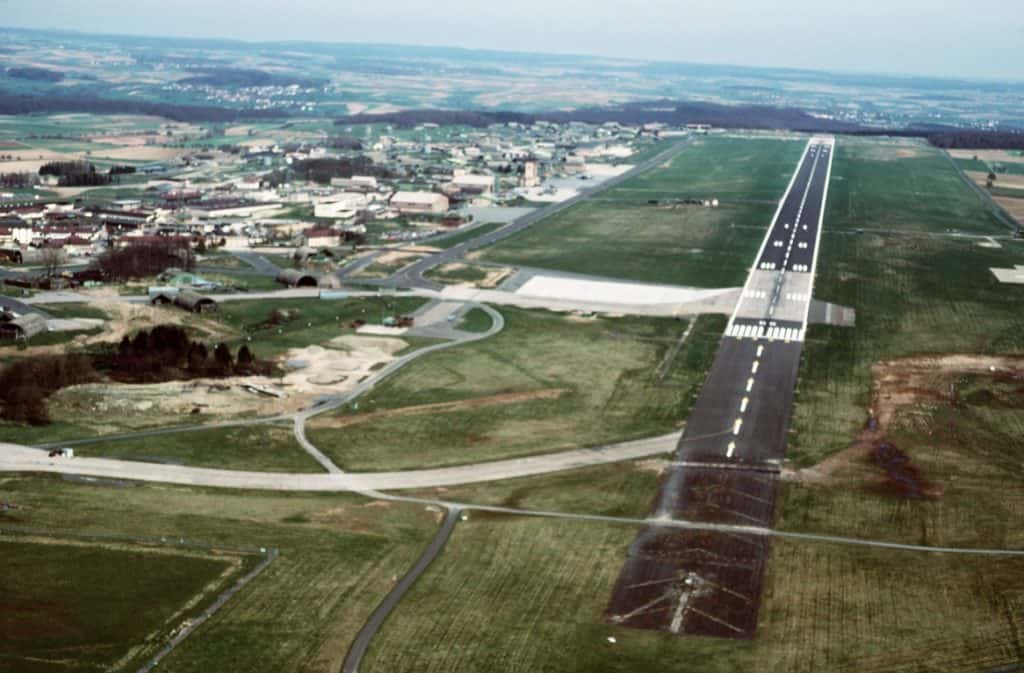Fire-fighting foams used on air bases by the U.S. military are poisoning water systems throughout Germany. The foam spray, used in routine fire drills, is made of a carcinogenic material known as Per and Poly Fluoroalkyl Substances, or PFAS. For training purposes, the American forces light massive, petroleum-fueled fires and extinguish them using these foam sprays. Afterward, the foam residue is allowed to run off, polluting the soil, sewers, surface water, and groundwater. The US military also uses sprinkler systems in hangars to create a foam layer to coat expensive aircraft. The frequently tested systems can cover a 2-acre hangar with 17 feet of poisonous foam in 2 minutes. (.8 hectare with 5.2 meters of foam in 2 minutes.)
The health effects of exposure to Per and Poly Fluoroalkyl Substances include frequent miscarriages and other severe pregnancy complications. They contaminate human breast milk and sicken breast-feeding babies. Per and poly fluoroalkyls contribute to liver damage, kidney cancer, high cholesterol, an increased risk of thyroid disease, along with testicular cancer, micro-penis, and low sperm count in males.
PFAS never degrades but it repels grease, oil, and fire better than anything ever developed. The military considers it indispensable in its war-fighting strategy because it’ll put out a fire in a hurry.
Remarkable technologies sometimes escape our control and imperil humanity, the way Pandora lost control of her box. These chemicals, and others like it, pose an existential threat to humanity. Following is a rundown of Germany’s most contaminated American bases.
Ramstein Air Base, Germany

– U.S. Air Force photo.

At Ramstein, groundwater was found to contain 264 ug/l (micrograms per liter) of PFAS. That’s 2,640 times above the threshold set by the European Union, (EU).
The EU has set standards for individual PFAS of 0.1 ug/L and for total PFAS of 0.5 ug/L in groundwater and drinking water. By contrast, the US Environmental Protection Agency has set a much stronger standard of .07 ug/l in drinking water and groundwater. However, the EPA’s measure is only voluntary while the military and industry contaminate water systems across the U.S. at thousands of times above the voluntary limits. Groundwater in Alexandria, Louisiana near the shuttered England Air Force Base was found to contain 10,900 ug/l of PFOS and PFOA.
Harvard University public health scientists say .001 ug/l of PFAS in our water is potentially hazardous.
The concentration of PFAS in the Glan River, below the confluence of the Mohrbach River, 11 kilometers from Ramstein, was 538 times the level the EU says is safe.

Airbase Spangdahlem, Germany

======================
Song of the Witches
William Shakespeare (from Macbeth)
For a charm of powerful trouble,
Like a hell-broth boil and bubble
===================
PFAS was measured at 3 ug/l close to Spangdahlem Airfield in the Märchenweiher Pond. (Marchenweiher means “fairy tale” in English.) The Fairy Tale Pond has turned to a nightmare. The fish are poisoned. The popular fishing waters have now been closed in consultation with the SGD Nord, the water management authorities in Rhineland-Palatinate. These chemicals never degrade.

When it rains at Spangdahlem, it pours PFAS. The contaminated rainwater retention basins at the airbase drain into Linsenbach Creek.
The Spangdahlem Airfield sewer treatment plant was found to have PFAS up to 31.4 μg / l. For comparison sake, the state of Maine recently set limits for PFAS in sewage sludge to 2.5 ug/l for PFOA and 5.2 ug/l for PFOS, although environmentalists say the regulations are ten times weaker than they should be.
The EPA does not regulate PFAS in sewer sludge. If it did, the military would be in mighty trouble, at least in the U.S. These deadly chemicals are transported from treatment plants across Germany and the U.S. and spread on farm fields. This results in poisoning the fields and crops where the carcinogenic sludge is applied. German farm produce is contaminated.

The municipality of Wittlich-Land, near the US/NATO Airbase Spangdahlem, filed suit against the German government in early 2019 for the costs of removing and disposing sewage sludge contaminated with PFAS. The lethal material cannot be spread on fields because it poisons crops, animals, and the water. Instead, it is incinerated, which is extraordinarily expensive and potentially devastating to human health and the environment
Wittlich-Land is not allowed to sue the U.S. military. Instead, it is suing the German government for damages. Meanwhile, the German government, which paid for the cleanup of the contaminants for years, has stopped doing so, leaving the town with the tab.
Airbase Bitburg, Germany

From 1952 until 1994, Bitburg Air Base was a front-line NATO air base. It was the home of the United States Air Force’s 36th Tactical Fighter Wing. PFAS was routinely used in fire-fighting foams.
In Bitburg, the groundwater was recently shown to contain PFAS at astonishingly high levels of 108 μg / l and the surface waters next to the airport had 19.1 ug/l of PFAS. Bitburg’s groundwater is a thousand times more polluted than E.U. standards.
These PFAS releases are believed by many to be a leading cause of autism and asthma in children. It affects puberty onset and contributes to attention deficit disorder. 99% of us now have some degree of these chemicals in our bodies.
Bitburg is contaminating local waterways with these toxins, much more so than in Spangdahlem or Ramstein. Concentrations of PFAS up to 5 ug/l were found in the Paffenbach, Thalsgraben and Brückengraben streams, popular fishing grounds. 5 ug/l is 7,700 times more than the E.U. limit. Fish consumption is associated with increased PFAS levels among the German population.
In Bitburg, which closed 25 years ago, the German government is “legally” responsible for the environmental destruction caused by the Americans. The German government expects the U.S. to pay the costs associated with active US airfields, according to the newspaper Volksfreund.

In parts of Germany, asparagus is being removed from the food chain as a result of its capacity to concentrate PFAS. Asparagus has an amazing ability to absorb PFAS from contaminated water and/or soil. Consumers should be wary of purchasing items like asparagus, strawberries, and lettuce because they often contain high levels of PFAS. Meanwhile, German government programs that sample for PFAS levels in various agricultural products have been effective in keeping many contaminated products from reaching the market.
Former NATO Airfield Hahn, Germany

Hahn Airfield housed the U.S. Air Force’s 50th Fighter Wing from 1951 to 1993. The site is the current location of Hahn-Frankfurt Airport. Like other bases, the rainwater retention basins have been a transport point for PFAS from the installation to the community. The Brühlbach River near Hahn had a maximum value of about 9.3 μg / l for PFAS. This is deadly. The amounts are astonishingly high because the watershed of Wackenbach Creek begins about 100 m of the former fire training pit. A little bit more math is in order. For surface waters, the E.U. says PFAS levels should not exceed 0.00065 ug/L. 9.3 ug/l is 14,000 times higher.
Büchel Airfield, Germany

In 2015 investigations on PFAS were carried out at the Büchel Airbase. Water samples were taken from the rainwater retention basins and the surrounding waters. PFOS was found at 1.2 μg / l.
Zweibrücken Air Base

Zweibrücken was a NATO military air base from 1950 to 1991. It housed the 86th Tactical Fighter Wing. It was located 35 miles SSW of Kaiserslautern. The site now serves as the civilian Zweibrücken Airport.
Surface waters next to the airport were found to have a maximum of 8.1 μg / L for PFAS. Most alarmingly, PFAS was found in neighboring drinking water self-supply systems at a maximum 6.9 μg / l. The EPA’s Lifetime Health Advisory for drinking water is .07 ug/l so the drinking water near Zweibrücken was found to be almost a hundred times that amount. Even so, environmentalists say the EPA’s drinking water advisory is extraordinarily weak. So weak, many states are enforcing much lower limits.
At George Air Force Base in California, female airmen were warned in the 1980’s, “don’t get pregnant” while serving there because of a high rate of miscarriages. More than 300 women have recently connected on Facebook, sharing stories of miscarriages, birth defects among their children and hysterectomies. They drank the water. The Air Force recently tested the water and found PFAS up 5.4 ug/l. It’s worse at Zweibrücken today. The stuff never goes away.
According to a report from the Bundestag (18/5905) just five U.S. properties in Germany were identified with PFAS contamination:
- US Airfield Ramstein (NATO)
- US airfield Katterbach
- US Airfield Spangdahlem (NATO)
- US military training area Grafenwoehr
- S. Airfield Geilenkirchen (NATO)
Two properties were “suspected” of PFAS use:
- S. Airfield Illesheim
- S. Airfield Echterdingen
According to the Bundestag, (18/5905), “Foreign armed forces are responsible for the pollution they cause and are obliged to investigate and eliminate them at their own expense.” At this point, the U.S. has not been proactive in cleaning up the contamination it has caused.
U.S. – German agreements call for determining the value of the improvements the Americans made to the land – minus the resulting environmental degradation when bases are transferred.
Two major problems have resulted from this general agreement. First, the two entities cannot seem to agree on the standards regarding clean-up, especially regarding the contamination of aquifers. Generally, the Americans have not been terribly concerned. Second, no one considered the devastating impact of Per and Poly Fluoroalkyl Substances on water systems.
Throughout Bundestag discussions of PFAS contamination from U.S. /NATO bases, the German federal government says it has “no specific knowledge” about environmental damage in areas that are not their property, however, groundwater and surface water contaminated by PFAS can travel for many miles outside of American bases.
Click to Subscribe to the Civilian Exposure Newsletter for Latest News & Updates Today!

